2 Automation & Human-Machine Symbiosis [Mumm]
Student Learning Objectives – The student will gain knowledge of the concepts and framework as it relates to the symbiosis of humans and machines and how this once futuristic idea is now a reality.
A Look Back at the Machine and Human Symbiosis Evolution
The idea that humans and machines would someday become interdependent upon one another was once considered science fiction and useful material for Hollywood films; however, it was not a scenario based on reality. This has all changed, and the interdependence of the human race on machines is becoming an integration that we can no longer ignore.
The Biology Dictionary lists the definition of symbiosis as “an evolved interaction or close living relationship between organisms from different species, usually with benefits to one or both of the individuals involved”. (Symbiosis Definition, 2020). See Figure 2.1.
Figure 2.1 Robot and Human Connecting (Middleton, 2018)
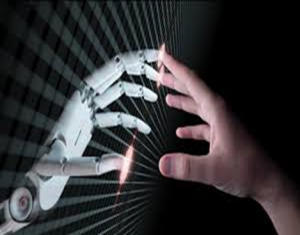
For this discussion, the humans are creating the autonomous systems (robots) for the benefit of the human race, which is deemed as an obligation in symbiosis in “which case the relationship between the two species is so interdependent, that each of the organisms is unable to survive without the other” (Symbiosis Definition, 2020). The case for an obligated symbiotic relationship can be made here as a ‘facultative’ relationship is based in the ability of the connection to be created by choice, because one entity can live without the other. In the year 2020 and beyond, it is clear humans have created a world where machines are essential to human survival. This survival is seen in many forms from daily activities, healthcare to national security and warfare as discussed in November of 2020 by the head of the British Army, General Sir Nick Carter, as he is forecasting “Thirty thousand “robot soldiers” could be fighting alongside humans in the near future as the British Army is forced to modernize” (Duncan, 2020). This would include small drones, unmanned ground vehicles, and unmanned underwater vehicles.
A look at how the human race is becoming more of a cyborg or a cyber organism is discussed from the lens of this being an endosymbiosis relationship “occurring when one of the symbiotic partners lives within the body of the other” (Symbiosis Definition, 2020).
The study of organic life and how it evolves is steeped in history, scientific theories, and documentation. This is in stark contrast to the very recent evolution of artificial intelligence and artificial life. In order to achieve full symbiosis between humans and machines
“may require that truly human-like characteristics be developed in intelligent machines. Such machines not only should be capable of human-like thinking, reasoning, and problem solving, but also should be capable of displaying human-like motivation, emotion, and personality, among other things.
Little is known about how a system will evolve over time and how this evolution will act and react in human settings such as the workplace and our overall society” (Sun, 2020).
The Fifth Industrial Revolution
Changes take time, resources, and evolutionary reasoning towards the betterment of humanity or a radical shift in our daily lives introduced in small measures. This pace of change is speeding up, and the time between shifts is shrinking, yet the effects of the change are magnified without a clear understanding of the consequences of actions and the reactions they cause. The fifth revolution will “take away mundane and repetitive tasks; it opens the way to curiosity, creativity, empathy, and judgment, ensuring a balance between people and technology” (Joseph, 2020). The rate of change will dwarf that of the past as the definition of the new revolution will herald that in “the Fifth Industrial Revolution, humans and machines will dance together, metaphorically” (Gauri, 2019). In a September 2020 article of The National, Patrick Noack states:
The speed of this revolution is unprecedented, and the impact is relevant to more and more people in increasingly diverse ways…the first of the revolutions lasted about 200 years. The second lasted 100, while the third about 50. It is easy to see the pattern here…during the fourth (revolution) we are hyperconnected through our smart devices to most of the planet. The fifth revolution will make that connection closer and seamless and will feel unmediated. The smart device on which we tap and into which we speak will disappear. Brain-computer interfaces will replace them. (Noack, 2020).
The aviation and maritime industries are steep in the history of humans and machine as the industrialization of our societies spread across the world. It was first the naval industry and later the aviation industry that allowed commerce to blossom and affordable travel to take hold. The change seen in these industries drove innovation, yet profit was the goal; this hallmark is what defines the shift as humanity “needs a Fifth Industrial Revolution to flower like a new Renaissance Age. It will be marked by creativity and common purpose, as we together work to bend progress and profits toward purpose and inclusivity” (Gauri, 2019).
Consider the motivations of innovations such as “Mr. Trash Wheel” as seen in Figure 2-2, as it depicts human-like qualities even though it is a sustainably powered trash interceptor invented in Baltimore, Maryland.
“Mr. Trash Wheel helps to connect the dots and helps residents understand the impact of their actions,” said Rebecca Woods, executive director of Baltimore’s Environmental Control Board. “Mr. Trash Wheel provides a point of education for upstream efforts in helping residents understand what happens to trash that enters streets and then storm drains. Woods said. “Mr. Trash Wheel (Figure 2.2) is that friendly face that provides my son comfort that trash will be blocked from entering the harbor. To my son, Mr. Trash Wheel is a hero” (Kossakovski, 2018).
Figure 2.2 Mr. Trash Wheel (Kossakovski, 2018)

The project offered a purpose greater than profit, as the amount of trash that is in harbors, docks, and even the open ocean is staggering. “Plastic, tires and other trash routinely flow into the harbor through the city’s storm sewers”. This innovation allows for more than just environmental cleanup; and it provides for profits towards a purpose of inclusivity as Mr. Trash Wheel “has collected more than 1.5 million pounds of trash since May 2014. It is powered by the harbor’s current and solar panels” (Kossakovski, 2018).
The fifth industrial revolution is poised to push the fourth revolution into the history books and take over sooner than one might think. Our preferred mode of communications moves from cell phones to brain waves, our data collection from the internet of things to 3-D sensor collection, allowing artificial intelligence freedom to roam far past our understanding. We might “check-in at the airport using a mind-reading bracelet or do our mind-supported shopping to guarantee our safety from infectious viruses… our use of these technologies will lay the foundations for yet a new revolution. What might the Sixth Industrial Revolution hold?” (Noack, 2020)
.
Human and Machine Joined – Cyborg or Evolutionary Inevitability?
Who would have ever thought that the television program “The Six Million Dollar Man” would not only become reality, but it would also be looked at as rudimentary in our evolution of integrating machines into humankind to improve our quality of life and ultimately extend our lives? The definition of a cyborg is “a person whose physiological functioning is aided by or dependent upon a mechanical or electronic device” ( Cyborg, 2020) or basically a bionic human or animal. Now the real question becomes, do machines evolve past humankind, becoming not only more intelligent but also self-aware and more like humankind?
Will robots continue to learn and study humans and their evolution for the purpose of evolving past humanity? What is not apparent is the pace at which authorities, responsibilities, strategic plans, and policies must change and evolve in order to help organizations understand their role in shaping a positive, proactive future.
The threat of unchecked technology, unmanned architecture development, and the ability to weaponize unmanned systems continues to evolve. Unmanned architecture technology advancements have offered more sophisticated abilities with cost-effective designs that have reduced the entry barrier for consumers, businesses, enemy states, and terrorist organizations. (Nichols, et al., 2019).
Elon Musk’s company, Neuralink, is working on creating a brain to machine interface which will allow for an integrated brain-machine symbiosis with thousands of channels to take advantage of the power of artificial intelligence. Musk has described it as a “Fitbit for your brain” and is envisioning that a robot will do the entire surgery to fit this coin-sized device into your brain. Musk admits that the ethical and safety issues will drive some of the early public’s adoption.
Figure 2.3 Neuralink Interface Process (Gilbert, 2019)

The device would read your brain through the interface as it is “connecting electrodes throughout the brain and reading its neuron signals en masse. (Figure 2.3) Gathering huge amounts of data from the signals would eventually teach Neuralink’s software how the brain uses them to communicate with the rest of the body” (Ioannou, 2020). Musk is quoted as stating, “It’s not just a measure of computerizing your brain, but a measure of potentially fixing complex neurological problems. “I think there’s an incredible amount we can do to solve brain disorders and damage” (Gilbert, 2019).
Reports published in the Journal of NeuroInterventional Surgery are hailing the first time a Stentrode device has allowed a human to control a computer by using their mind, without wires or machine intervention. The device is inserted into the brain via a small keyhole incision (Lavars, 2020). Figure 2.4 shows the device next to a matchstick. The patient, Phillip O’Keefe, has had a Stentrode device implanted and
Figure 2.4 Stentrode device compared to a matchstick (Lavars, 2020)
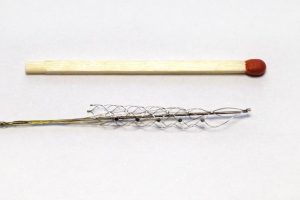
the implant records his brain activity and transmits it wirelessly to a small receiver worn on his chest, and onward to a computer that translates the signals into onscreen commands… to surf the internet, write emails, do part-time work in data entry, and check his online banking. By thinking about moving his left ankle, he is able to perform a mouse click (Lavars, 2020).
This incredible symbiosis offers us a glimpse into the idea that “technology will bend back towards the service of humanity, marked by creativity and a common purpose…empower(ing) us to close the historic gap and create a new socio-economic era” (Joseph, 2020).
Cyborgs and cyborg soldiers of all forms and fashion are featured in Hollywood movies and Sci-Fi novels. These cyborg soldiers are no longer characters in sci-fi thrillers. As depicted in Figure 2.5, the troops of the future will have computers embedded in their craniums. The Defense Advanced Research Projects Agency (DARPA)
Figure 2.5 Mind-Controlled Troops Connected to Weapons Systems (West, 2018)
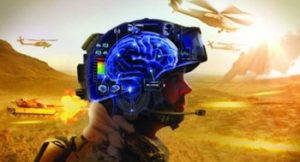
is selecting teams to develop a “neural interface” that would both allow troops to connect to military systems using their brainwaves and let those systems transmit back information directly to users’ brains. The Next-Generation Non-Surgical Neurotechnology, or N3, program aims to combine the speed and processing power of computers with humans’ ability to adapt to complex situations, DARPA said. In other words, the technology would let people control, feel, and interact with a remote machine as though it were a part of their own body (West, 2018). (See Figure 2.6)
Figure 2.6 Mockup of U.S. SOCOM’s TALOS suit (Rempfer, 2019)
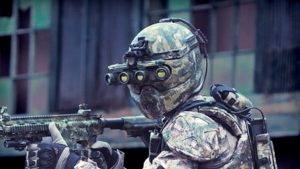
Figure 2-6 illustrates the future soldier with additional sensors to allow the soldier to autonomously send and receive information. The implications of a machine talking directly into a human mind in the middle of a high stress, highly emotional situation such as combat is not understood or even discussed within most available literature. The consequences to the human or to the battlefield are not known as “these interactions would allow warfighters direct communication with unmanned and autonomous systems, as well as with other humans, to optimize command and control systems and operations” (Rempfer, 2019). All of this is with a questionable ability to interject ethics and with minor regard as to what long term effects it will have on the human soldiers.
Traversing the Seas with New Autonomous Technologies
The seas are generally regarded as a very unforgiving place where a mix of factors from weather to technology combined with the operator’s experience will determine success or failure in successful navigation or just surviving this environment. Future Defense USA in Alexandria, Virginia, is developing an optionally piloted advanced technology vessel known as the Thunderchild to the defense market and later to the civilian arena. The boat will be outfitted with complimentary autonomous systems based on the customers’ requirements (DiDonato, 2020). (Figure 2.7)
Figure 2.7 The Thunderchild (Kowalski, 2020)

The Thunderchild already holds world records for speed in navigation, and with the ability to operate in sea state six, which encompasses wind speeds over 25 knots, and wave heights of over 3 meters, this capability allows the Thunderchild to operate where most of the worlds Coast Guards and Navies are not able to. This technology will have the ability to be optionally piloted, allowing for maximum flexibility for manned operations when required or unmanned operations to take advantage of the advances in communications, navigation, and a lower operating cost than currently available (DiDonato, 2020).
Surface vessels are quickly moving to full autonomy with the help of some large IT companies. IBM has invested in moving autonomy forward with its Mayflower Autonomous Ship (MAS). It is currently sailing and is slated to re-trace the original 1620 Mayflower sea route to commemorate the 400th anniversary of the Mayflower ocean voyage. MAS will use IBM’s advances in AI and edge computing (Figure 2.8):
to sense, think and make decisions at sea, even with no human intervention… with no human captain or onboard crew, it will become one of the first full-sized, fully autonomous vessels to cross the Atlantic. The mission will further the development of commercial autonomous ships and help transform the future of marine research.” (IBM News Room, 2020)
Figure 2.8 MAS (IBM News Room, 2020)
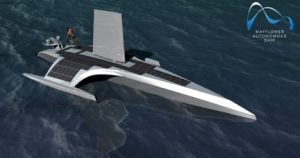
Unmanned underwater vehicles (UUVs) will be used for logistics, research, and offensive and defensive weapons. The US Navy is working quickly to increase its offensive undersea drone capabilities as
“The maritime domain has yet to see the kind of explosive innovation that UAVs have brought to land warfare… autonomous systems promise to bring to the undersea domain the kind of new capabilities and offensive punch, the Navy has yet to fully tap their potential” (Frandrup, 2019).
The new era of unmanned submarines and the implications of where the technology will lead humankind is under “The influence of massive spending on developing AI for undersea systems portends the greatest change in military sea power since the introduction of nuclear-powered vessels”. (Wilson, 2019) See Figure 2.9.
Figure 2.9 Boeing Echo Voyager Extra-Large Unmanned Underwater Vehicle (XLUUV) (Wilson, 2019)
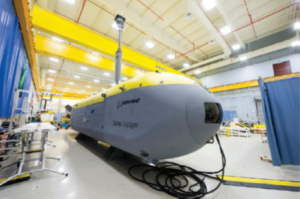
The research missions of UUVs are countless, yet they have their limitations. Terradepth, a Texas company, is working on solving the power and longevity issues that plague many research missions. Terradepth is working on a tag-team design of an unmanned submersible they named AxV. (Figure 2.10)
Figure 2.10 Diagram illustrating the Terradepth system (Coxworth, 2020)
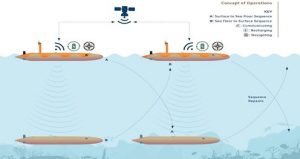
The submerged AxV likewise gathers undersea data, running purely on battery power. When that battery starts getting low, the vehicle automatically surfaces near its counterpart. It then fires up its generator and starts recharging its battery, while the AxV that had been traveling at the surface submerges to take its place underwater (Coxworth, 2020).
Terradepth has had such successful sea trials of the technology in November 2020 that they are continuing to expand the capabilities beyond the current depth of 6,000 meters. The next power solution set they are working to incorporate is an air-breathing hydrogen fuel cell system.
Technology can be used for good or evil; it just depends on how the technology is employed. In November 2020, the US Drug Enforcement Agency (DEA) captured a hard to detect narcotics carrying submarine near Choco, Colombia. (Figure 2.11)
Figure 2.11 Electric Narco-Submarine (Sutton, 2020)
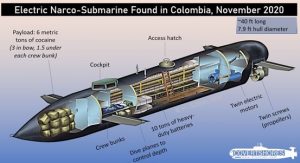
This “fully submersible electric-powered submarine makes it very hard to trace. The vehicle was capable of carrying 6 tons of cocaine. The street value of such a huge amount stands at an estimated $120 million USD” (Kundu, 2020). Although not unmanned yet, it is clear to see that the narco-traffickers are working on undersea logistics to move their products. It will only be a matter of time before they add unmanned underwater vehicles to their fleet.
Advancement in unmanned submersibles is tied directly to the improvements in the AI field. AI vessels are not just being limited to nefarious uses; many governments are working on broadening mission sets for national defense. China has made “achievements in AI-enabled unmanned surface vessels, which it plans to use to patrol and bolster its territorial claims in the South China Sea. It has also tested unmanned tanks as part of research efforts to integrate AI into ground forces” (Tadjdeh, 2020).
It is clear that the symbiosis of human and machine to harness the power of the seas is quickly approaching; technology laws, policies, and governance still have a long way to go before man and machine can claim victory.
Human Symbiosis Disrupts the Aviation Industry
In examining the idea of human symbiosis and the aviation industry, most thoughts immediately go to UAVs or drone type aircraft. However, the optionally piloted aircraft/vehicle (OPV) allows for the symbiosis in a more trusting and understood manner. If an aircraft is only able to be flown by the computer itself, and no human intervention is possible when a fault occurs, humans quickly start to distrust the sensors, computers, and AI systems. Nowhere is this example clearer than that of the Lion Air and the Ethiopian Airline Boeing 737-Max 800 aircraft crashes that occurred respectively in 2018 and 2019.
A preliminary report from Indonesian investigators indicates that Lion Air 610 crashed because a faulty sensor erroneously reported that the airplane was stalling. The false report triggered an automated system known as the Maneuvering Characteristics Augmentation System, or MCAS. This system tried to point the aircraft’s nose down so that it could gain enough speed to fly safely (Hawkins, 2019).
The sensors that were supposed to create a human symbiosis with the aircraft ended up creating confusion and causing the crash of two airliners, killing 346 persons, and grounding the entire fleet of aircraft. The cost to Boeing and the airline industry is in the billions, the FAA lifted the grounding order for the 737 Max as of December 3, 2020.
The ability to have an optionally piloted helicopter has been demonstrated by Airbus in 2017. Airbus has stated that the “The OPV (Figure 2.12) is able to autonomously take-off, hover and perform stabilized flight and maneuvers…VSR 700 flight control system is a fully-digital, multi-channel system with a very high level of redundancy. It takes advantage of Airbus Helicopters unique expertise in digital autopilots” (VSR700 demonstrator performs first autonomous flights, 2017).
Figure 2.12 VSR 700 OPV (VSR700 demonstrator performs first autonomous flights, 2017)
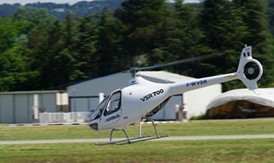
Boeing is working diligently in the arena of OPVs that handle passenger traffic (Figure 2.13). In January of 2019, Boeing’s unmanned passenger aircraft completed its first flight as it “tested the prototype’s autonomous functions and ground control systems, according to Boeing. Subsequent test flights will check forward and wing-borne flight and the transition between vertical and forward flight modes” (Abel, 2019).
Figure 2.13 Boeing Unmanned Passenger Aircraft (Abel, 2019)
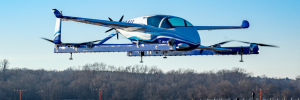
This OPV “was designed and developed in partnership with Boeing NeXt and Boeing subsidiary Aurora Flight Sciences. John Langford, president, and CEO of Aurora Flight Sciences, stated, “Certifiable autonomy is going to make quiet, clean and safe urban air mobility possible” (Abel, 2019). The next project for Boeing is reportedly an unmanned electric cargo aircraft that will carry up to 500 pounds.
Airbus is also working on a pilotless commercial jet. Airbus has been testing the aircraft and confirmed that “while completing alignment on the runway, waiting for clearance from air traffic control, we engaged the autopilot and the A350-1000 achieved eight automatic takeoffs over a period of four and a half hours” (Hardingham, 2020). See Figure 2.14.
Figure 2.14 A350-1000 Pilotless Commercial Aircraft (Hardingham, 2020)

Even without a fully pilotless aircraft, passenger jets are currently landing with the “assistance of on-board computers with pilots manually fly the aircraft for just a few minutes on average… Autonomous technologies are paramount to supporting pilots, enabling them to focus less on aircraft operation and more on strategic decision-making and mission management” (Hardingham, 2020).
Further into the future of aviation and human symbiosis is the promise of what is being called Ion Thrusters that allows flight without a liquid type fuel. See Figure 2.15.
Figure 2.15 Ion Thruster Rendering ( IFL Science, 2020)
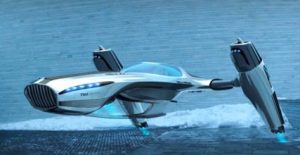
This technology is being created by a team led by Steven Barrett from the Massachusetts Institute of Technology (MIT), the “so-called electro aerodynamic-powered plane, one that uses solid-state propulsion, meaning no propellers or jet engines with expendable fuel” ( IFL Science, 2020)
The idea of humankind and flying machines working together in a symbiotic relationship is moving further toward reality. The technologies and public policies that regulate this technology must align better in the future in order for humans to trust the machines and the machines, understanding their role in serving humanity.
Integrating Artificial Employees-The Changing Horizon of Human Resources
There is an old saying that all problems are people problems, which gives rise to the issue of employees in the fifth revolution as “we are unprepared to meet the challenges ahead. According to a recent World Economic Forum Report, for example, 65% of children entering the school system today will end up in careers that don’t exist yet” (Gauri, 2019).
The study of organic life and how it evolves is steeped in history, scientific theories, and documentation. This is in stark contrast to the very recent evolution of artificial intelligence and artificial life. Little is known about how a system will evolve over time and how this evolution will act and react in human settings such as the workplace and our overall society. Can a virtual or physical robot (autonomous system) truly understand the needs, emotions, and motivations of a human? If this is possible using AI, the autonomous systems “can anticipate what a human will need and will do, it can provide better assistance. Furthermore, if it can appreciate, for example, the frustration that a human feels, then it can help to find solutions” (Sun, 2020).
The potential risk for “ loss to an organization from an Artificial Employee (AE) making autonomous decisions is enormous” (Brand, 2019). The Canadian Chief Scientific Officer of Kindred Biomedical states, “A subset of the artificial intelligence development in the next few decades will be very human-like. I believe these entities should have the same rights as humans…robots fundamentally have to make mistakes in order to learn” (Wong, 2017). The risk could potentially be every bit as great as that of human error. Research in this area tends to use the Grounded Theory as it lends itself well to organizations and human resource issues. The grounded theory research approach “presents promising possibilities for the development of theoretical frameworks that emerge from research situated in practice and enhance the Human Resource Development (HRD) theorist” (Egan, 2002). There appears to be very few organizations with a plan for increasingly autonomous machines capable of deep learning, as
“these machines are considered physical assets as opposed to intelligence assets” (Brand, 2019). Machines do not have the same issues as humans who have self-determined and intrinsic motivations and thus are capable of autonomous choice of action in accordance with these motivations…include not only power, achievement, and other individualistic tendencies, but also adherence to social norms, affiliation with other individuals, and other tendencies related to social cooperation and interdependence” (Sun, 2020).
Most corporations adopt risk management, ethics, or training and development plans for human employees. By contrast, machines with any level of intelligence are considered physical assets and are managed as such. However, a thinking machine is capable of choices, actions, and decision making, much like that of its human counterpart. If a machine can make an autonomous decision or action, “the behavior of the machine must be managed and responsible for outcomes assigned” (Brand, 2019). If so, training, monitoring, and development programs must be considered for managing the AEs in many of the same ways human employees are managed. On a deeper level, human and machine resources must be observed and managed in their interactions. The machines that will make thinking decisions could have much broader implications and the humans that interact with them will respond based on human needs and human concerns.
Any organization relying on a human to make an intelligent decision has some employee oversight system in place. An entire field of employment and research is dedicated to the complex task of managing humans and their decisions. The hypothesis is an equally in-depth system of management is called for when managing intelligent machines, with a focus on differences in the decision making and task completion methodology. In Ethical Dilemmas in the Age of AI, Abramson states, “In the distant future, some machines may have to make decisions for humans. In the case of empathy, imagine a robot having to decide if resuscitation attempts on a deceased human should be undertaken, and if so, for how long?” (Abramson, 2016).
In January 2017, and again in 2018, the European Union passed a motion adopting a report that calls for the development of “electronic personhood” – regulations for robots and AI systems “granting special legal status, or “electronic personalities,” to smart robots, specifically those which can learn, adapt, and act for themselves (Withers, 2018). Although this legislation has not passed yet, it appears that it will be approved in the next few years as countries and companies start to tackle the issue of leveraging Artificial Employees.
There are far too many issues and questions to address in this chapter, however, as a parting thought on this topic, consider what happens if a human goes on vacation – who monitors the AE? What is liability for a mistake by the AE? What about AE maintenance? How do you terminate an AE? Is it a loss to the company/government, or is it employee replacement? What could a company potentially lose or be liable for?
Conclusions
Additional theoretical models and frameworks should be explored in this challenging environment with many complex issues that have yet to be discovered. Future research implementing these theoretical models and frameworks should be used to fill the knowledge gaps related to evolving approaches and innovative solutions that could complement the speed of human/machine progress. If a machine can make an autonomous decision or action, the behavior of the machine must be managed and responsible for the result.
The cyborg soldier of the future will “mentally link up with the various weapons systems at their disposal…this would also be a two-way system that could enable the systems to transmit information back to the soldier as well” (West, 2018). If so, training, monitoring, and development programs must be considered for managing the symbiosis of human and machines in many of the same ways we manage human employees. A broad range of cognitive architectures needs to be investigated as the human mind “needs to deal with all of its functionalities: perception, categorization, memory, decision-making, reasoning, problem-solving, communication, action, learning, metacognition, motivation, and so on” (Sun, 2020). The demand for AI and human symbiosis models capable of working with these broad functionalities needs to be better scoped for future research and integration if we are to hope for true human-machine symbiosis.
Time will tell if the human resources, maritime, and aviation industries can all successfully adjust into this new world. Human-machine symbiosis appears to be just over the horizon; it will also require guidance to incorporate the correct mix of policies and laws to support a complimentary partnership to this new reality instead of a hindrance.
Questions
- What is the difference between symbiosis and the industrial revolution?
- Do you think human evolution will migrate to us all being cyborgs? Why or Why not?
- List three disruptive technologies in the aviation industry.
- How would you to take advantage of the disruptive nature of the fifth industrial revolution and human symbiosis?
- Name three ways that the maritime industry is benefiting from the fifth industrial revolution and the inclusion of human symbiosis in next-generation technologies.
References
Cyborg. (2020, December 8). Cyborg. Retrieved from https://www.dictionary.com/browse/cyborg: https://www.dictionary.com/browse/cyborg
IFL Science. (2020, December 10). Scientists Have Created A Star Trek-Like Plane That Flies Using “Ion Thrusters” And No Fuel. Retrieved from https://www.iflscience.com/technology/: https://www.iflscience.com/technology/scientists-have-created-a-star-treklike-plane-that-flies-using-ion-thrusters
Abel, K. (2019). Boeing’s Unmanned Passenger Aircraft Completes First Flight. South Sound Business. Retrieved from https://southsoundbiz.com/: https://southsoundbiz.com/boeings-unmanned-passenger-aircraft-completes-first-flight/
Brand, K. (2019, December 7). Research in Artificial Employee Management. . Retrieved from www.kathrynbrand.com: www.kathrynbrand.com
Coxworth, B. (2020, December 10). Place-trading AUVs designed for longer oceanographic missions. Retrieved from https://newatlas.com/: https://newatlas.com/marine/terradepth-axv-auv/?utm_source=New+Atlas+Subscribers&utm_campaign=1a2437bb47-EMAIL_CAMPAIGN_2020_12_10_02
DiDonato, R. (2020, December 12). Future Defense USA [Interview]. Retrieved from https://www.futuredefenseamd.com/: https://www.futuredefenseamd.com/
Duncan, C. (2020). Thousands of ‘robot soldiers’ could be fighting in British army in near future, UK military chief says. Retrieved from https://www.independent.co.uk/: https://www.independent.co.uk/news/uk/politics/robot-soldiers-british-army-nick-carter-https://www.independent.co.uk/news/uk/politics/robot-soldiers-british-army-nick-carter-b1705452.html
Egan, T. M. (2002). Grounded Theory Research and Theory Building. Advances in developing human resources , pp. 4(3), 277-295. .
Frandrup, C. E. (2019). The US Navy Needs Offensive Undersea Drones. Retrieved from https://www.defenseone.com/: https://www.defenseone.com/ideas/2019/11/us-navy-needs-offensive-undersea-drones/161548/
Gauri, P. &. (2019, May 5). What the Fifth Industrial Revolution is and why it matters. . Retrieved from https://europeansting.com/: https://europeansting.com/2019/05/16/what-the-fifth-industrial-revolution-is-and-why-it-matters/
Gilbert, B. (2019). Elon Musk finally took the wraps off his new brain microchip company that plans to connect people’s brains to the internet by next year. Retrieved from https://www.businessinsider.com/: https://www.businessinsider.com/what-is-elon-musk-brain-chip-company-neuralink-2019-7
Hardingham, T. (2020). Are we one step closer to pilotless commercial jets? . Retrieved from https://www.cnn.com/: https://www.cnn.com/travel/article/airbus-pilotless-commercial-jets/index.html
Hawkins, A. (2019). Everything you need to know about the Boeing 737 Max airplane crashes. Retrieved from https://www.theverge.com: https://www.theverge.com/2019/3/22/18275736/boeing-737-max-plane-crashes-grounded-problems-info-details-explained-reasons
IBM News Room. (2020, December 12). Sea-Trials-Begin-for-Mayflower-Autonomous-Ships-AI-Captain. Retrieved from https://newsroom.ibm.com/: https://newsroom.ibm.com/2020-03-05-Sea-Trials-Begin-for-Mayflower-Autonomous-Ships-AI-Captain
Ioannou, L. (2020, Dec 7). Elon Musk demonstrates brain-computer tech Neuralink in live pigs. Retrieved from https://www.cnbc.com/: https://www.cnbc.com/2020/08/28/elon-musk-demonstrates-brain-computer-tech-neuralink-in-live-pigs.html
Joseph, T. (2020). How the 5th Industrial Revolution is Advancing Humanity at Workplace. Retrieved from https://www.fingent.com/: https://www.fingent.com/blog/how-the-5th-industrial-revolution-is-advancing-humanity-at-workplace/
Kossakovski, F. (2018, December 6). Mr. Trash Wheel cleans up Baltimore Harbor with a dash of humor. Retrieved from https://www.pbs.org: https://www.pbs.org/newshour/science/mr-trash-wheel-cleans-up-baltimore-harbor-with-a-dash-of-humor
Kundu, A. (2020, November 24). DEA catches stealthy narco submarine in Colombia. Retrieved from https://www.fleetmon.com/maritime-news/: https://www.fleetmon.com/maritime-news/2020/31729/dea-catches-stealthy-narco-submarine-colombia/
Lavars, N. (2020, December 7). Brain implant allows mind control of computers in first human trials. Retrieved from https://newatlas.com/: https://newatlas.com/medical/stentrode-brain-implant-mind-control-first-trials/#:~:text=in%20the%20neck-,Stentrode%20was%20implant
Middleton, C. (2018). SAP launches ethical A.I. guidelines, expert advisory panel. Retrieved from internetofbusiness.com: Middleton, C. (2018). SAP launches ethical A.I. guidelines, expert advisory panel. Retrieved from https://internetofbusiness.com/sap-publishes-ethical-guidelines-for-a-i-forms-expert-advisory-panel/
Nichols, R. K., Mumm, H. C., Lonstein, W. D., Ryan, J. J., Carter, C., & and Hood, J.-P. (2019). Unmanned Aircraft Systems in the Cyber Domain. Manahattan, KS: New Prairie Press. Retrieved from https://newprairiepress.org/ebooks/27/
Noack, P. (2020, December 9). The Fifth Industrial Revolution: where mind meets machine. Retrieved from https://www.thenationalnews.com/: Noack, P. (2020). The Fifth Industrial Revolution: where mind meets machine. The National News(August 9 2020). https://www.thenationalnews.com/opinion/comment/the-fifth-industrial-revolution-where-mind-meets-machine-1.1061280
Rempfer, K. (2019, November 27). Cyborg warriors could be here by 2050, DoD study group says. . Retrieved from https://www.armytimes.com/news/: https://www.armytimes.com/news/your-army/2019/11/27/cyborg-warriors-could-be-here-by-2050-dod-study-group-says/
Sun, R. (2020). Potential of full human–machine symbiosis through truly intelligent cognitive systems . AI & Society, pp. 35(1), 17-28. https://doi.org/10.1007/s00146-017-0775-7 .
Symbiosis Definition. (2020, November 18). Retrieved from https://biologydictionary.net/symbiosis/: https://biologydictionary.net/symbiosis/
Tadjdeh, Y. (2020, October 30). China Threatens U.S. Primacy in Artificial Intelligence. Retrieved from https://www.nationaldefensemagazine.org/: https://www.nationaldefensemagazine.org/Articles/2020/10/30/China%20Threatens%20US%20Primacy%20in%20Artificial%20Intelligence
VSR700 demonstrator performs first autonomous flights. (2017, December 17). Retrieved from https://www.airbus.com/newsroom/: https://www.airbus.com/newsroom/press-releases/en/2017/06/VSR700.html
West, N. (2018, December 8). DARPA Researching Mind-Controlled Troops Connected to Weapons Systems. Retrieved from https://www.thedailybell.com/: https://www.thedailybell.com/all-articles/news-analysis/darpa-researching-mind-controlled-troops-connected-to-weapons-systems
Wilson, J. R. (2019). Unmanned submarines seen as key to dominating the world’s oceans: Unmanned underwater vehicles (UUVs) are driving pioneering research in artificial intelligence (AI) underwater communications, autonomous navigation, and unmanned swarm technologies. Military & Aerospace Electronics , 30(8), 10-19. .

